The Atlas Mountains stand as one of Morocco’s most breathtaking natural wonders, beckoning travelers to embark on an unforgettable adventure. Nestled within this majestic mountain range is a diverse tapestry of experiences, from conquering the peaks of North Africa’s highest summits to immersing oneself in the rich cultural heritage of traditional Berber villages.
Located within reach of Marrakech, a popular tourist hub, the Atlas Mountains offer the perfect blend of accessibility and escapism, making it an ideal destination for both day trips and extended explorations. The region’s unique geography gives rise to distinct experiences across its various ranges, including the High Atlas, Middle Atlas, and Anti-Atlas.
This comprehensive guide will walk you through planning your perfect Atlas Mountains adventure, providing insider tips on the best times to visit, what to pack, and how to maximize your experience in this mountainous paradise.
Key Takeaways
- Discover the diverse activities and cultural experiences available in the Atlas Mountains.
- Learn how to plan your trip, including when to visit and what to pack.
- Explore the unique geography and distinct experiences across different mountain ranges.
- Understand the accessibility of the Atlas Mountains from Marrakech.
- Get insider tips on making the most of your adventure in the Atlas Mountains.
The Majestic Atlas Mountains: Morocco’s Natural Wonder
The Atlas Mountains, a majestic mountain range in North Africa, are a natural wonder that has captivated travelers and adventurers alike. This extensive series of mountain ranges stretches for almost 2,000 kilometers across Morocco, Algeria, and Tunisia.
Geography and Location of the Atlas Mountain Ranges
The Atlas Mountains are not just a single range but a collection of several mountain ranges, with the High Atlas, Middle Atlas, and Anti-Atlas being the most prominent in Morocco. The High Atlas is the most famous and tallest, featuring peaks that are snow-capped for much of the year.
- The Atlas Mountains form a natural barrier between the Mediterranean basin and the Sahara Desert.
- The mountain range has created diverse ecosystems, from lush valleys to arid plains.
- The geography of the Atlas Mountains has significantly influenced the climate of Morocco.
The Cultural Significance of the Atlas Mountains
The Atlas Mountains have been the ancestral home of the Berber (Amazigh) people for thousands of years. The rugged terrain has shaped their traditional way of life, architecture, and cultural practices.
- The mountains have served as both a protective barrier and a crossroads for trade and cultural exchange.
- The Atlas Mountains continue to be vital to Morocco’s economy through agriculture, tourism, and as a source of water.
Best Time to Visit the Atlas Mountains
To experience the Atlas Mountains at their best, it’s crucial to choose the right time of year for your visit. The region offers a diverse range of experiences throughout the year, making it a year-round destination.
Seasonal Weather Patterns
The Atlas Mountains are most accessible between March and November. During spring (March-May), the landscape is lush with vegetation and wildflowers, and temperatures are mild. Summer months (June-August) see a significant temperature difference between the lowlands and highlands, with the High Atlas remaining relatively cool.
Autumn (September-November) brings stable weather and fewer crowds, making it an ideal time to visit. Winter (December-February) brings snow to the higher peaks, ideal for winter mountaineering.
| Season | Weather | Activities |
|---|---|---|
| Spring (March-May) | Mild temperatures, lush vegetation | Hiking, trekking |
| Summer (June-August) | Warm in lowlands, cool in highlands | Hiking, exploring |
| Autumn (September-November) | Stable weather, fewer crowds | Trekking, sightseeing |
| Winter (December-February) | Cold, snowy peaks | Winter mountaineering |
What to Pack for Your Atlas Mountains Adventure
Packing for your adventure in the Atlas Mountains should be based on the season. Essentials include sturdy hiking boots, layered clothing, sun protection, and rain gear. For winter visits, specialized equipment is necessary.
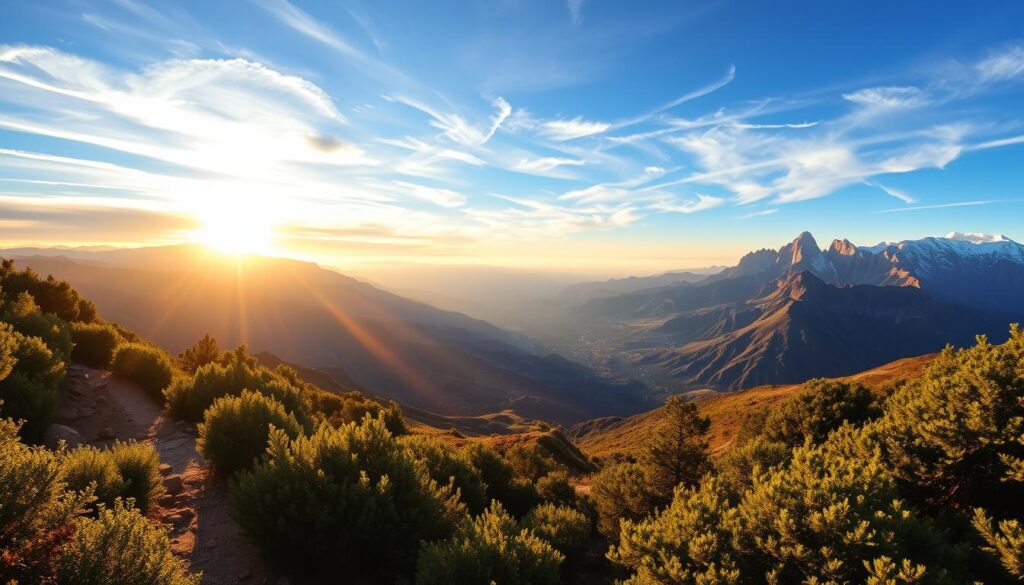
Conquering Mount Toubkal: North Africa’s Highest Peak

Mount Toubkal, standing tall at 4,167 meters, is the highest peak in North Africa and a magnet for hikers and adventure seekers. It’s a challenging yet rewarding experience that attracts many to the Atlas Mountains.
The Toubkal Climbing Experience
The standard route to the summit is a two-day trek, where hikers typically stop overnight at either the Mouflon or Neltner mountain refuge at around 3,200 meters. The next morning, an early start is made to reach the summit in time for sunrise.
Preparing for the Toubkal Challenge
While the climb is non-technical, being in peak physical condition is crucial. Hiring a guide is mandatory, not just for safety but to enhance the cultural experience. Climbers should also be prepared for altitude effects and potential snow conditions, especially if climbing in winter.
Exploring Traditional Berber Villages
Nestled in the Atlas Mountains, Berber villages showcase the rich cultural heritage of the Amazigh people. The traditional flat-roofed homes, made from packed stone and earth, seem to have grown from the mountains themselves, blending harmoniously with the surrounding landscape.
Authentic Cultural Encounters
Visiting these villages offers an authentic glimpse into a lifestyle that has remained largely unchanged for centuries. The Amazigh people make a living through farming and herding livestock, using age-old techniques to live in the fertile valleys between the forbidding slopes.
Experiencing Berber Hospitality and Cuisine
The Berber culture is known for its warm hospitality, welcoming visitors into their homes for a cup of steamy Moroccan mint tea, nicknamed “le whiskey Berbere.” Traditional Berber cuisine features tagines, couscous, and fresh bread baked in communal ovens, using seasonal produce grown in the fertile mountain valleys.
| Experience | Description |
|---|---|
| Homestay with Berber Family | Learn traditional cooking methods, bread making, and crafts like weaving or pottery. |
| Local Cuisine | Enjoy tagines, couscous, and fresh bread, accompanied by seasonal produce. |
| Cultural Immersion | Participate in daily Berber life, gaining insights into their traditions and way of life. |

Hiking Adventures in the High Atlas
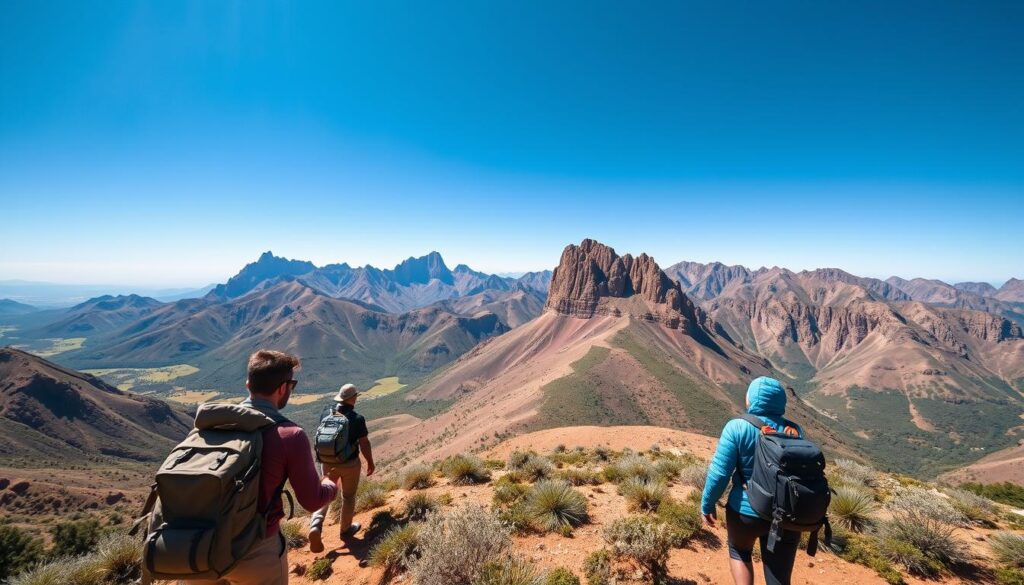
Hiking in the High Atlas Mountains is an experience unlike any other, with breathtaking views and challenging trails. The region offers a diverse range of hiking routes suitable for all levels, from gentle half-day walks to multi-day treks across rugged terrain.
Popular Hiking Trails for All Levels
The Atlas Mountains are home to numerous hiking trails, including the Ouirgane Valley trails and Imlil Valley walks, which showcase traditional villages and spectacular mountain vistas. For more experienced hikers, the M’Goun Massif trek and the Ait Bougmez Valley circuit offer challenging routes through rarely visited parts of the High Atlas.
The Morocco Three Peaks Challenge
For the ultimate hiking adventure, consider the Morocco Three Peaks Challenge. Over 48 hours, participants summit Morocco’s three highest mountains: Toubkal and the twin peaks of Mount Ouanoukrim. The challenge requires physical preparation and acclimatization to high altitudes, but the experience is unparalleled.
Discovering the Breathtaking Valleys
Discovering the valleys of the Atlas Mountains is a journey through Morocco’s varied natural beauty. The Atlas Mountains encompass a series of valleys, each offering unique landscapes and experiences.
Ourika Valley: Lush Landscapes and Waterfalls
The Ourika Valley is a popular destination, located just an hour’s drive from Marrakech. It boasts lush green landscapes, a flowing river, and traditional pottery shops. Visitors can hike to the famous waterfalls near Setti Fatma, enjoying panoramic views of the surrounding mountains.
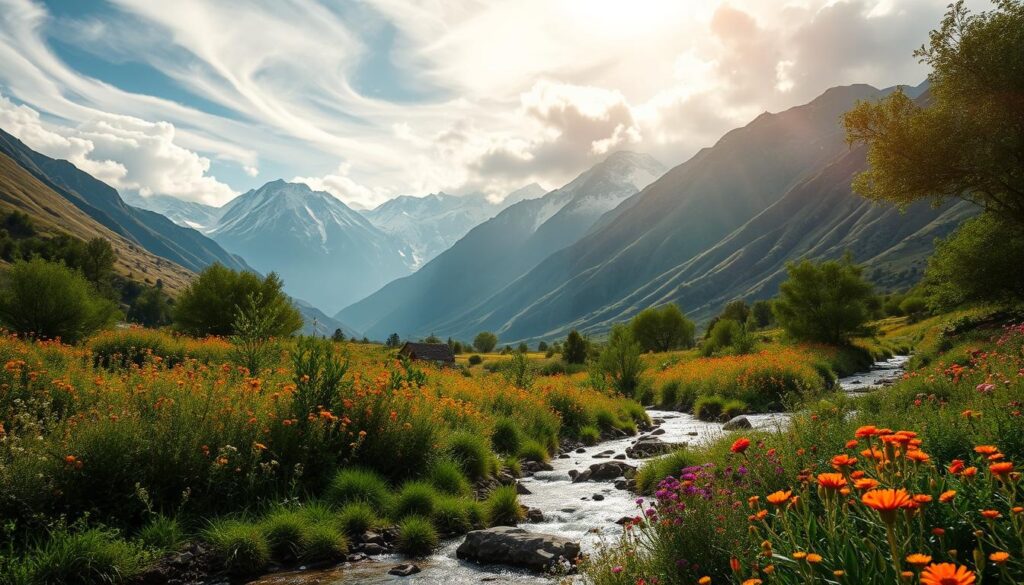
Dadès Valley: Dramatic Scenery and Rock Formations
In contrast, the Dadès Valley, often called the “Valley of a Thousand Kasbahs,” presents dramatic scenery with striking red rock formations and ancient fortified villages. It’s a paradise for photographers and driving enthusiasts, with its serpentine road and switchbacks. A trip to the Dadès Valley offers an unforgettable experience amidst the Atlas Mountains‘ diverse valleys.
Things to Do in Atlas Mountains Morocco Beyond Hiking
While hiking is a popular activity, the Atlas Mountains have a wealth of other exciting things to do. The region offers a diverse range of activities that cater to different interests and adventure preferences.
Mountain Biking Adventures
Mountain biking is a thrilling way to experience the Atlas Mountains. Cyclists can tackle winding mountain roads and high passes, with routes suitable for both experienced riders and those looking for leisurely rides. A bikepacking tour through the Dadès Valley is highly recommended, offering breathtaking lunar-like landscapes between the High Atlas Mountains and the Jbel Saghro Mountains.
Hot Air Balloon Rides Over the Mountains
For a serene and breathtaking experience, consider a hot air balloon ride over the Atlas Mountains. At sunrise, the mountains are bathed in golden light, offering a bird’s-eye view of the dramatic landscapes. This is an unforgettable way to witness the natural beauty of the region.
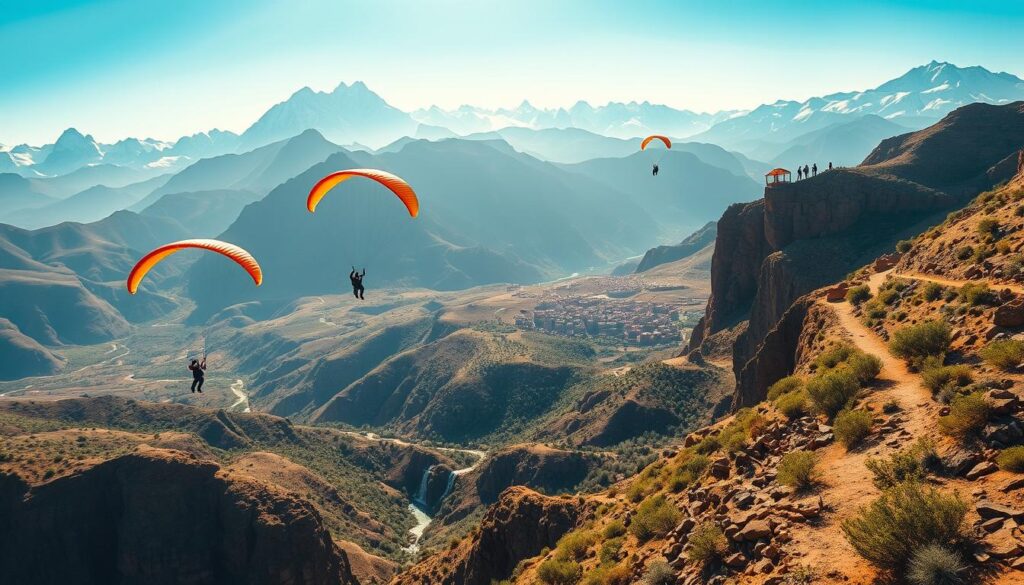
Rock Climbing in Todra Gorge
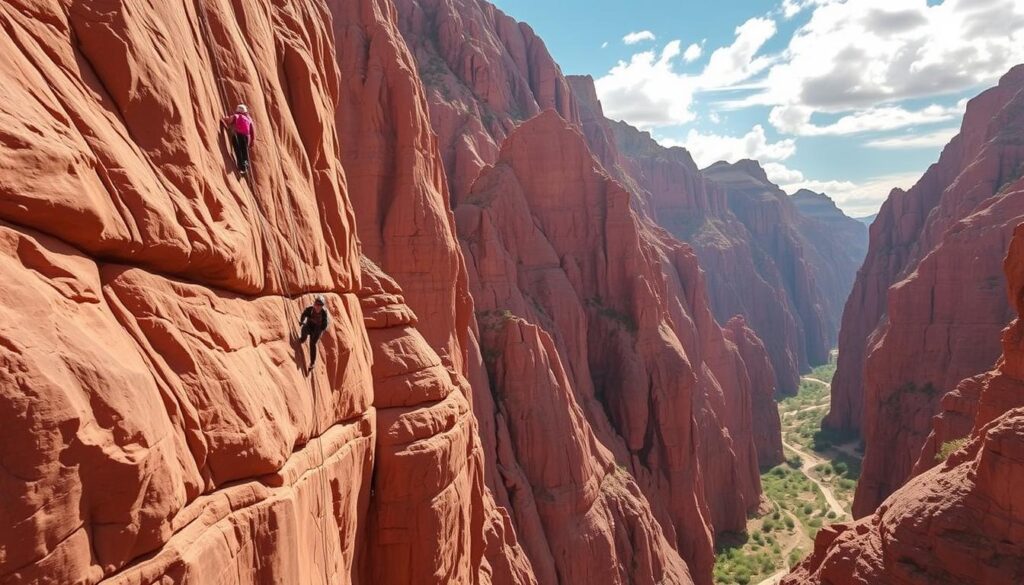
The majestic Todra Gorge, with its towering 400-meter walls, is a premier destination for rock climbing enthusiasts worldwide. Located in the eastern part of the High Atlas Mountains, this spectacular limestone canyon offers a unique climbing experience.
Todra Gorge is renowned for its distinctive red rock faces and varied climbing routes, making it an attractive destination for climbers of all skill levels. The cultural experience of climbing in Morocco adds another layer of excitement, setting it apart from climbing destinations in Europe or America.
Routes for Beginners and Experienced Climbers
For beginners, Todra Gorge offers easier sport climbing options near the entrance, where the walls are lower and the routes are well-bolted. This makes it an accessible and safe location for those new to the sport. Experienced climbers, on the other hand, can enjoy more challenging multi-pitch climbs on the higher walls, which offer technical challenges and spectacular views of the surrounding landscape.
The importance of hiring a local guide cannot be overstated, especially for novice climbers. Guides provide essential equipment, safety briefings, and tailor the climbing experience to match the climber’s skill level, ensuring a safe and enjoyable adventure in the gorge.
Safety Tips and Equipment Needs
When planning to climb in Todra Gorge, it’s crucial to consider the best seasons for climbing. Spring and fall are ideal due to the mild weather, while the summer heat can be challenging. Climbers should also be prepared for changing weather conditions. In terms of equipment, climbers can either bring their own or rent locally. Understanding the climbing infrastructure at the gorge is also important for a smooth experience.
For those looking to stay for multiple days of climbing, there are various accommodation options available near the gorge, ranging from simple guesthouses to more comfortable hotels. This allows climbers to fully immerse themselves in the climbing experience that Todra Gorge has to offer.
Visiting Women’s Argan Cooperatives
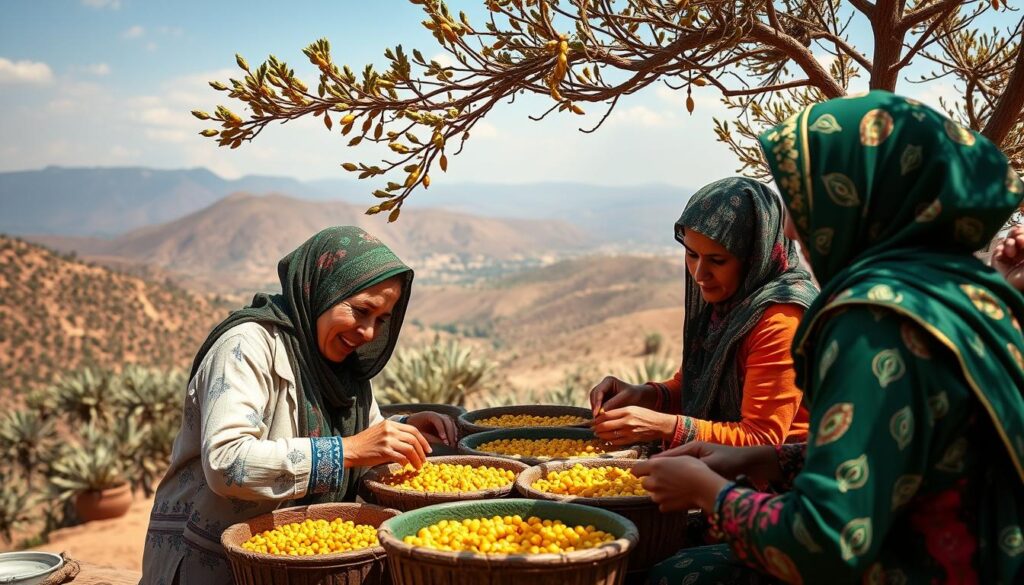
One of the most enriching experiences for visitors to the Atlas Mountains is touring a women’s argan cooperative. These cooperatives offer a unique glimpse into the traditional practices of Berber women.
Learning About Traditional Argan Oil Production
The process of producing argan oil is labor-intensive and involves harvesting nuts from the argan tree, which is found exclusively in the southern part of Morocco. Visitors can expect to see demonstrations of this process, from manually cracking the nuts to extracting the oil.
Supporting Local Women’s Livelihoods
By visiting these cooperatives, people from the Atlas Mountains area benefit directly. The cooperatives empower rural women by providing them with income, independence, and business skills. Purchasing products directly from these cooperatives ensures fair compensation for the artisans and helps sustain traditional knowledge and practices.
Many trip atlas day tours include stops at these cooperatives, making them accessible even for travelers with limited time. Visitors can enjoy tastings of argan products and traditional Moroccan tea, enhancing their cultural experience in the Atlas Mountains.
Waterfalls of Setti Fatma
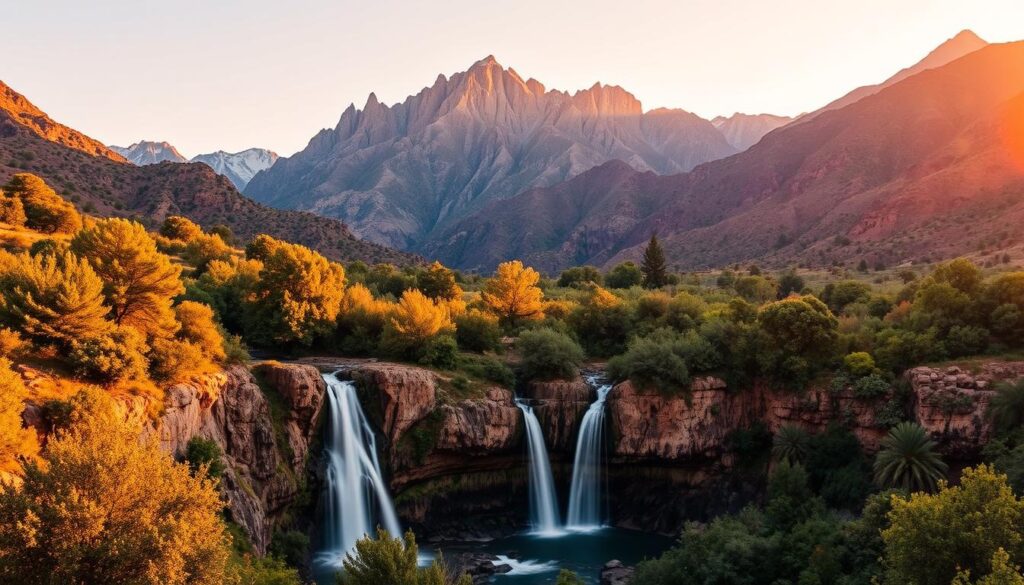
Setti Fatma, with its series of cascading waterfalls, is one of the most visited and beloved natural attractions in the Atlas Mountains region. The destination is particularly famous for its seven waterfalls, making it a unique spot for hikers and nature enthusiasts.
The Hiking Trail to the Seven Waterfalls
The hiking trail to the Setti Fatma waterfalls is approximately a 2-3 hour round trip to reach the first few falls. While not particularly long, the trail involves some technical sections, including river crossings and climbing over slippery rocks, which require careful footing. The trail begins at the base of the valley, where visitors can find a small shopping area with souvenir stands and cafes.
As hikers ascend, they are treated to increasingly impressive views of the waterfalls. Most day-trippers visit only the first waterfall, but more adventurous hikers can continue to explore all seven falls. The trail becomes progressively more challenging and less crowded beyond the first cascade.
Practical Tips for Visiting Setti Fatma
To make the most of a visit to Setti Fatma, it’s advisable to arrive early to avoid crowds, especially on weekends. Sturdy hiking shoes with good grip are essential due to the slippery rocks and river crossings. Visitors should also bring water, sun protection, and a small backpack for essentials.
The best time to visit Setti Fatma is in the spring when snowmelt increases the water flow, making the waterfalls more impressive. However, visitors should be cautious of potential flash flood dangers during heavy rain periods. After the hike, visitors can relax at the restaurants and cafes at the base of the trail, many of which offer traditional Moroccan meals served on colorful cushions alongside the river.
Hiring a local guide is highly recommended as they can help navigate the sometimes confusing path, assist with difficult sections, and share knowledge about the area’s natural and cultural history. Guides are available at the entrance to the trail.
Atlas Mountains Day Trips from Marrakech
Experience the best of Morocco’s Atlas Mountains with a convenient day trip from Marrakech, featuring stunning scenery and authentic cultural encounters.
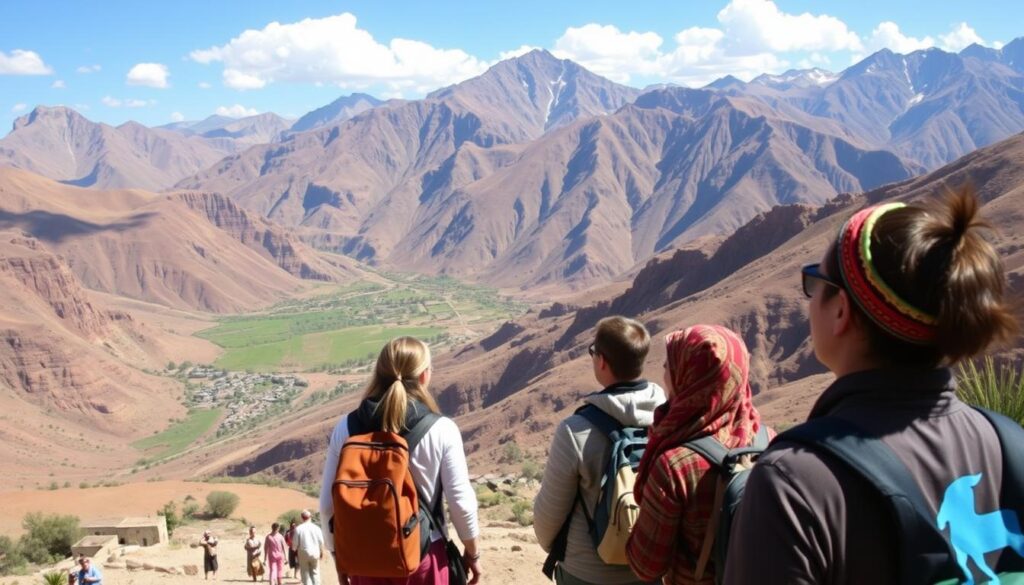
What to Expect on a Guided Tour
A typical Atlas Mountains day tour includes transportation in a comfortable vehicle, usually a minivan for small groups, visits to Berber villages, stops at panoramic viewpoints, a visit to a women’s argan cooperative, hiking to Setti Fatma waterfalls, and often a traditional Berber lunch in a local home.
These tours are designed to provide a comprehensive experience, showcasing the natural beauty and cultural richness of the Atlas Mountains. With a knowledgeable local guide, you’ll gain insights into the region’s history, culture, and geography.
Self-Guided vs. Organized Tours
While self-guided tours offer flexibility, organized tours provide a hassle-free experience with pre-arranged logistics and cultural insights. With a guided tour, you can enjoy the scenery without worrying about navigating unfamiliar mountain roads.
For those who prefer a more personalized experience, private tours are available, offering flexibility with itinerary, pace, and timing. This option is ideal for families, photographers, or those with specific interests.
When planning your trip, consider the benefits of guided tours, including knowledgeable local guides, pre-arranged experiences with local families, and cultural insights that would be difficult to access independently.
Where to Stay in the Atlas Mountains
The Atlas Mountains offer a diverse range of accommodations, allowing visitors to immerse themselves in the mountain environment and culture.
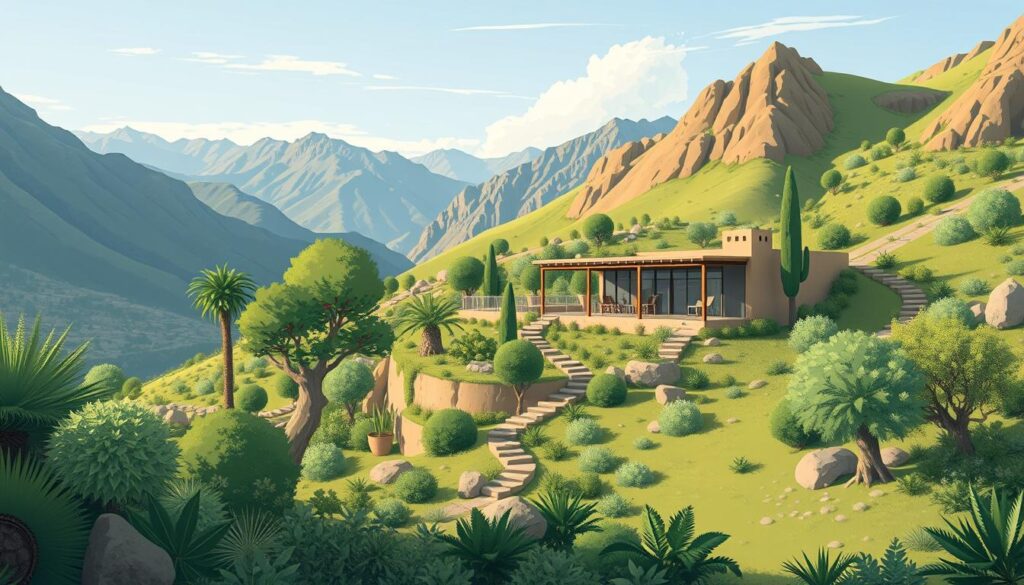
Luxury and Sustainability
Luxury ecolodges and kasbahs in the Atlas Mountains blend high-end amenities with sustainable practices, offering panoramic views and locally-sourced cuisine.
These establishments are designed to limit their footprint on the rugged landscape, providing an authentic experience.
Authentic Experiences
Visitors can opt for authentic homestays with Berber families, participating in daily activities like bread baking and farming, gaining insight into a traditional way of life.
Popular areas for overnight stays include Imlil, Ouirgane, and the Ourika Valley, each offering a unique experience.
Conclusion: Embracing the Magic of Morocco’s Atlas Mountains
Morocco’s Atlas Mountains are a treasure trove of adventure, culture, and natural beauty. The High Atlas range offers a diverse array of experiences, from challenging mountain treks to cultural immersion in traditional Berber villages.
Visitors can enjoy a day trip from Marrakech or embark on a multi-day tour to explore the mountains and valleys. The region’s unique blend of culture and scenery makes it an attractive destination for travelers seeking adventure or relaxation.
With plenty of activities to choose from, including hiking, mountain biking, and hot air balloon rides, there’s something for every type of traveler. To preserve the natural environment and cultural heritage, visitors are encouraged to adopt responsible tourism practices, such as supporting local guides and staying in sustainable accommodations.
Whether you’re an adventure seeker or a luxury traveler, the Atlas Mountains offer an unforgettable experience. Plan your trip according to the season to enjoy the best of what the region has to offer.